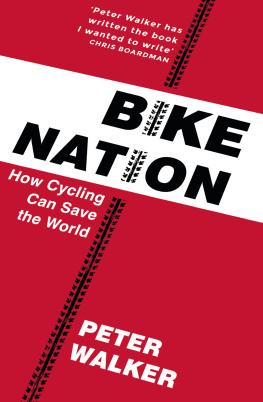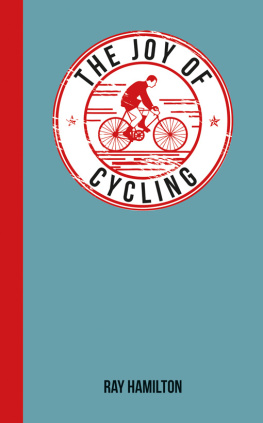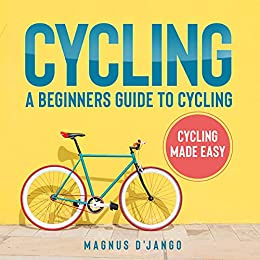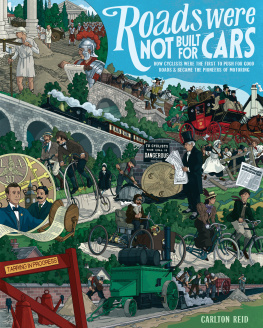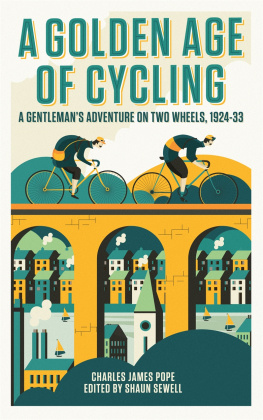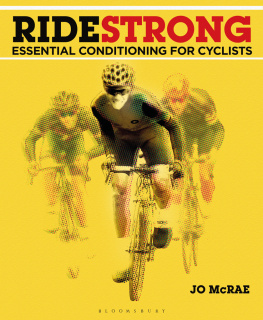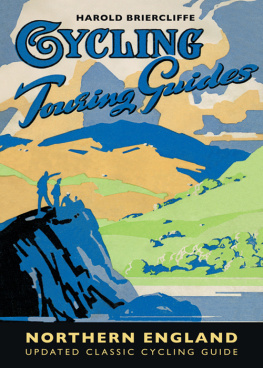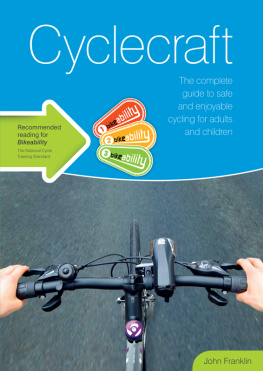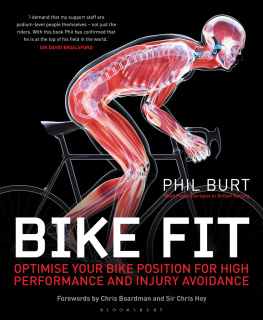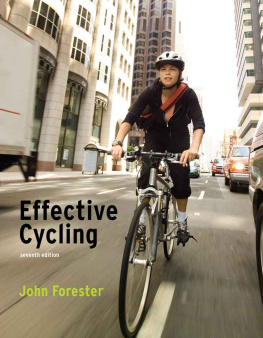PETER WALKER
BIKE NATION
How Cycling Can Save the World

This ebook is copyright material and must not be copied, reproduced, transferred, distributed, leased, licensed or publicly performed or used in any way except as specifically permitted in writing by the publishers, as allowed under the terms and conditions under which it was purchased or as strictly permitted by applicable copyright law. Any unauthorized distribution or use of this text may be a direct infringement of the authors and publishers rights and those responsible may be liable in law accordingly.
Epub ISBN: 9781473548794
Version 1.0
1 3 5 7 9 10 8 6 4 2
VINTAGE
20 Vauxhall Bridge Road,
London SW1V 2SA
Vintage is part of the Penguin Random House group of companies whose addresses can be found at global.penguinrandomhouse.com.
Copyright Peter Walker 2017
Cover detail Getty images
Peter Walker has asserted his right to be identified as the author of this Work in accordance with the Copyright, Designs and Patents Act 1988
First published by Yellow Jersey in 2017
penguin.co.uk/vintage
A CIP catalogue record for this book is available from the British Library
ISBN 9781911214946
For Shelly
ACKNOWLEDGEMENTS
A huge number of people helped with this book, not least those who talked me through their many areas of expertise Im very grateful to all of them. Particular thanks should go to those who also showed me around their cities, pointing out the things that work for bikes, and the things that dont.
Extra thanks to Doug Gordon, of the Brooklyn Spoke blog, who assisted me hugely with people to talk to in the United States (and took me on a marathon tour of New York Citys bike lanes). Also to Mark Wagenbuur, who runs the Bicycle Dutch blog, and kindly translated the Stop de Kindermoord article in .
Gratitude also to colleagues at the Guardian, my day job, who have spent several years patiently listening to my regular talk about cycling.
Finally, huge thanks to Alison Tulett, the copy editor, Alice Brett, who proofread the book, to my wonderful editor, Tim Broughton, and my fantastic agent, Rachel Mills.
INTRODUCTION
NOT EVERYONE ON A BIKE IS A CYCLIST
It was about 10.30 on a sunny Sunday morning, a couple of days before I sat down to write this, when the flotilla of cyclists came into view from around a corner. There must have been about thirty of them, riding more or less every sort of bike you could imagine. At the front, pedalling an ancient folding machine at a sedate, regal cadence, was a woman probably in her sixties, wearing red trousers and a bright blue visor to shield her eyes from the glare. As I watched from the pavement she gave me a grin in passing.
Behind her were men and women of various ages, a few dressed up in the default city cycling garb of luminous jacket and shiny helmet, but most in ordinary clothes, on very everyday bikes. I had no idea if they were some sort of unfathomable organised group, or whether the arbitrary actions of traffic lights and chance had somehow coalesced them into this wonderful, accidental peloton.
But then the thought struck me: either way, these people wouldnt have been here just a few months ago.
Here was a road in central London called Lower Thames Street, which, as its name suggests, adjoins the river that flows through the city. An ancient thoroughfare it was mentioned in the citys eleventh-century customs records the road was widened and rebuilt in the 1960s: turned into the sort of double-lane urban motorway so popular in that era, when the dominance of the car appeared absolute and for ever.
After this happened, very few cyclists would ride on Lower Thames Street, which becomes the equally inhospitable Upper Thames Street as it heads west. It tended to be only the gung-ho and bold who did so, almost all young men, often professional cycle couriers in a hurry, those who didnt mind holding a lane amid a stream of taxis and trucks, speeding under the bridges and along the concrete canyons. I have always been a reasonably confident rider, but I would avoid Lower Thames Street if I could. It just wasnt fun. The idea of a woman in her sixties choosing to cycle along it, even on a Sunday morning, would have been absurd. Such riders were excluded from large sections of their city.
So what changed? It was nothing more than a bike lane. In 2014, Lower and Upper Thames Street were selected to form part of the route for one of Londons first two modern Dutch-style routes boldly called Cycle Superhighways which would shield riders from the motor traffic with continuous kerbs, protected junctions, and bike-only traffic light sequences.
This was a controversial process. Businesses along the way objected, saying the lanes would bring London to a halt. The trade group representing the citys iconic black cabs openly laughed at the idea that there were enough riders to fill such broad bike thoroughfares. Outside of rush hour they would be unused, it predicted a failure, a tumbleweed-strewn embarrassment.
In May 2015 the lanes opened: a long east-to-west route taking in Lower Thames Street and a shorter route going from south to north. And then the cyclists arrived. In a mass.
What was at the time my regular route to work saw me head along the northsouth Superhighway. I had begun cycling in London some years before, when to do so made you something of a freak, an exception. In those days, other riders were sufficiently rare that youd sometimes nod to each other in acknowledgement as you passed. Suddenly, on the new, separated lane, I found myself waiting at traffic lights amid a pack of two dozen or more cyclists, with a similar-sized horde paused at the other side of the junction.
For me, more interesting even than the numbers was the identity of these new riders. Londons bike culture has long been dominated by speedy young men riding rapid bikes in specialised clothing, a product of the feral traffic culture and lack of dedicated provision for cyclists. But now other people were emerging on bikes: older, younger, slower, dressed in ordinary clothes, not riding lightweight racing bikes with ultra-skinny ty res.
This book is ultimately about such everyday riders, and the astonishing and varied ways in which they can transform the urban environment and way of life for the better. Its about people like the sixty-something woman with the visor and her motley gang of followers.
In fact, you could even say this book isnt about cyclists at all. In one sense it is, of course. It describes the many wonderful and unexpected ways that lives and societies can improve if only more people decide they are happy to ride a bike. And if you ride a bike, youre cycling, and thus a cyclist. Correct?
Well, yes and no. In many places, particularly the UK, America, Australia, or anywhere else where the private car still dominates, if you tell someone Im a cyclist, theyre likely to make a few instant assumptions. Youre an enthusiast. An advocate, even. You ride everywhere, and make a vocal point of doing so. You might have opinions about gear ratios and a drawer full of garish, figure-hugging bike clothes.
I partly fall into that category. I have cycled regularly, and occasionally over long distances, for a couple of decades. While Im a news journalist Ive also written quite a bit about cycling issues for my paper, the

